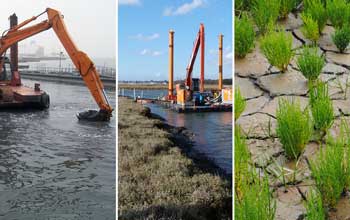
There has been a strong desire amongst Solent Forum members to find solutions to the many barriers which are preventing the effective use of dredged material to augment Solent intertidal sites and, hence, to provide other benefits associated with such restoration work (especially enhanced coastal protection). The Forum’s role will be to manage the project and facilitate future communications. For more detailed information please download the BUDs Solent Terms of Reference.
The Solent Forum now seeks to build on past work and lead on the development of a proposal that will:
More specifically the project will aim to:
This work should build on a wealth of information much of which relates to the Solent including amongst others work from the River Hamble Harbour Authority, the University of Southampton and Lymington Harbour. It is important that the work does not replicate previous work and that the budget is used to further the delivery of beneficial use projects.
It will only be possible to make real advances in the Solent if the benefits of the re-use of dredging material is really understood and costed, and these benefits are aligned to objectives of regulatory bodies and coastal managers.
The project comprises three phases. Download the project brief.
Phase 1 of the project was conducted by ABPmer. This phase included a Stakeholder Workshop. The main areas of work included:
Feasibility Study and Detailed Cost Benefit
Develop options for the Solent for a project(s) for beneficial use within a set time period and for preferred options to develop full feasibility plans for actual use of dredging at some key sites. Key site selected: Western Solent and Lymington Marshes. To consider whether a scheme may be a one off or one that can be repeated. This study would detail exact timings and costs of sources of sediment to match with receiver site needs. It would identify funding sources for complete projects. The beneficial costs will be firmed up so as to fully calculate cost benefit. Licences and permissions to be fully scoped ready to obtain. EIAs conducted.
ABPmer were contracted for this work.
The Phase 2 report was published in February 2020.
Stakeholder Working
Key stakeholders helped develop strategic guidance and a protocol. Led by the Solent Forum it built on from Phase 1 work, using workshops and stakeholder meetings. Specifically it:
The aim of this phase is to secure a Marine Licence (and any other necessary consents) that will enable the bottom placement of sediment in two locations in the Western Solent (west of Lymington), by third parties operating under their own dredge disposal licence. It will include all consents and permissions to place the dredgings and the identification of a methodology/system that will enable third parties to have a viable alternative to their current practices of offshore disposal. Completion of this phase will mark an important step for BUDS and the overall objective of the project. Once the grounds become used, income can be derived to ensure that on-going project costs are met including any monitoring costs. Phase 3 will evaluate these monitoring costs.
Please see the project brief for more information. This phase started in April 2021 and will conclude in 2024.
A disposal site characterisation assessment has been prepared to inform the MMO marine licence application for two new beneficial use sites in the Lymington saltmarshes. This licence application delivers the bulk of phase 3. A further short report will be produced to summarise the work, the MMO response, provide further detail on the adaptive management and funding, phase 4 procurement details, conclusions and next steps. At this stage a meeting with the Project Group will be sought.
In the event that the application is successful and disposals made at these sites, there will be a requirement for monitoring.
This phase will need to be costed on completion of Phase 3 and a detailed project plan agreed by the project group. This plan will need to identify who will manage phase 4 and secure funding.